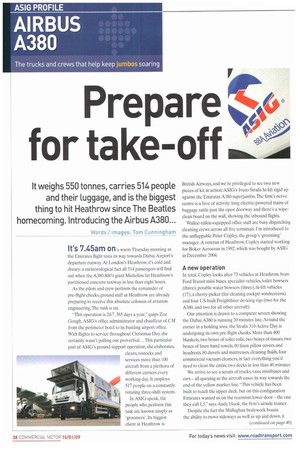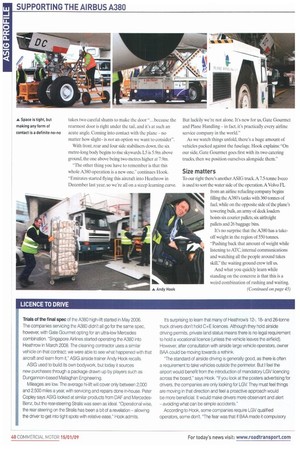Prepare p ; for take off .
Page 38

Page 40

Page 43

If you've noticed an error in this article please click here to report it so we can fix it.
It weighs 550 tonnes, carries 514 people and their luggage, and is the biggest thing to hit Heathrow since The Beatles homecoming. Introducing the Airbus A380...
Words / images: Tom Cunningham Its 7.45am 0 11 a warm Thursday morning as the Emirates flight taxis its way towards Dubai Airport's departure runway. At London's Heathrow, it's cold and dreary: a meteorological fact all 514 passengers will find out when the A380-800's giant Michelins hit Heathrow's partitioned concrete taxiway in less than eight hours.
As the pilots and crew perform the remainder of pre-flight checks, ground staff at Heathrow are already preparing to receive this absolute colossus of aviation engineering. The rush is on.
"This operation is 24/7,365 days a year," quips Zoe Gough, ASIG's office administrator and chauffeur of CM from the perimeter hotel to its bustling airport office. With flights to service throughout Christmas Day, she certainly wasn't pulling our proverbial... This particular part of ASIG's ground support operation, she elaborates, cleans, restocks and services more than 100 aircraft from a plethora of different carriers every working day. It employs 517 people on a constantly rotating three-shift system.
In ASIG-speak, the people who perform this task are known simply as 'groomers'. Its biggest client at Heathrow is British Airways, and we're privileged to see two new pieces of kit in action: ASIG's Iveco Stralis hi-lift rigid up against the Emirates A380 superjumbo.The firm's nerve centre is a hive of activity: long electric-powered trains of baggage rattle past the open doorway and there's a wipeclean board on the wall, showing the inbound ffights.
Walkie-talkie-equipped office staff are busy dispatching cleaning crews across all five terminals. I'm introduced to the unflappable Peter Copley, the group's 'grooming' manager. A veteran of Heathrow, Copley started working for Boker Aerocean in 1992, which was bought by ASIG in December 2004.
A new operation
In total, Copley looks after 73 vehicles at Heathrow, from Ford Transit mini buses, specialist vehicles, toilet bowsers (three), potable water bowsers (three), hi-lift vehicles (17), a cherry-picker (for cleaning cockpit windscreens) and four US-built Freightliner de-icing rigs (two for the A380, and two for all other aircraft).
Our attention is drawn to a computer screen showing the Dubai A380 is running 20 minutes late. Around the corner in a holding area, the Stralis 310 Active Day is undergoing its own pre-flight checks. More than 400 blankets, two boxes of toilet rolls, two boxes of tissues, two boxes of linen hand towels. 90 linen pillow covers and headrests, 80 duvets and mattresses, cleaning fluids, four commercial vacuum cleaners, in fact everything you'd need to clean the entire two decks in less than 40 minutes.
We arrive to see a SCTUM of trucks, vans, minibuses and cars — all queuing as the aircraft eases its way towards the end of the yellow marker line. "This vehicle has been built to reach the upper deck, but on this configuration Emirates wanted us on the rearmost lower door — the one they call L5," says Andy Hook, the firm's airside trainer.
Despite the fact the Mallaghan bodywork boasts the ability to move sideways as well as up and down, it takes two careful shunts to make the door "...because the rearmost door is right under the tail, and it's at such an acute angle. Coming into contact with the plane no matter how slightis not an option we want to consider".
With front, rear and four side stabilisers down, the six metre-long body begins to rise skywards. L5 is 5.9m above ground, the one above being two metres higher at 7.9m.
"The other thing you have to remember is that this whole A380 operation is a new one," continues Hook. "Emirates started flying this aircraft into Heathrow in December last year. so we're all on a steep learning curve. Hut luckily we're not alone. It's new for us, Gate Gourmet and Plane Handling in fact. it's practically every airline service company in the world."
As we watch things unfold, there's a huge amount of vehicles packed against the fuselage. Hook explains: "On our side, Gate Gourmet goes first with its two catering trucks, then we position ourselves alongside them."
Size matters
To our right there's another ASIG truck. A 7.5-tonne Iveco is used to sort the water side of the operation.A Volvo FL from an airline refueling company begins filling the A380's tanks with 360 tonnes of fuel, while on the opposite side of the plane's towering bulk, an army of deck loaders hoists six courier pallets, six airfreight pallets and 26 baggage bins.
It's no surprise that the A380 has a takeoff weight in the region of 550 tonnes. -Pushing back that amount of weight while listening to ATC, internal communications and watching all the people around takes skill," the waiting ground crew tell us.
And what you quickly learn while standing on the concrete is that this is a weird combination of rushing and waiting. If Hook's Stralis failed to make it to the aircraft on time, or the 35 'groomers' failed to service the cabin in the allotted 40 minutes, all hell would break loose, "Delays cause a problem for connecting passengers: our performance is measured against delays," Copley says. With Hook and his colleagues off the aircraft and returning to base, it's turned into a waiting exercise.
Back in the office, Hook reflects on a job well done. The Stralis performed 'admirably and the aircraft left with a full complement of blankets, towels and toiletries.
An issue of height
Copley joins Hook to give me an overview of the vehicle we've seen and the fleet in general. "We've got an inherent problem at Heathrow and it's one of height. We need a large internal capacity, stable vehicles to service the A380, but the tunnels and underpasses are on the low side," they agree. Copley admits the Iveco-based hi-lift could be used on smaller aircraft, but its sheer size means it will only be used on other high, wide-bodied jets such as the Boeing 747 and 777s.
As time passes and more of these giant aircraft fly, the process will he slicker and the vehicle acquisition process simpler. Under the current schedule. ASIG services only one A380 a day, but from this month it will be servicing three aircraft (two Emirates and one Qantas). •




















































































































































